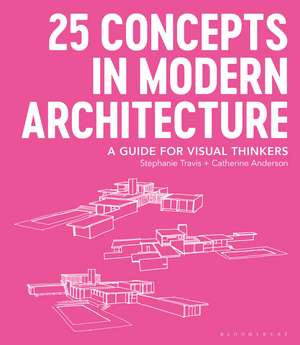25 Concepts in Modern Architecture: A Guide for Visual Thinkers
Autor Stephanie Travis, Catherine Andersonen Limba Engleză Paperback – 22 sep 2021
Preț: 197.87 lei
Preț vechi: 242.19 lei
-18% Nou
Puncte Express: 297
Preț estimativ în valută:
37.87€ • 41.12$ • 31.81£
37.87€ • 41.12$ • 31.81£
Carte disponibilă
Livrare economică 01-15 aprilie
Livrare express 15-21 martie pentru 83.78 lei
Preluare comenzi: 021 569.72.76
Specificații
ISBN-13: 9781350055605
ISBN-10: 1350055603
Pagini: 216
Ilustrații: 341 colour illus
Dimensiuni: 200 x 230 x 18 mm
Greutate: 0.67 kg
Editura: Bloomsbury Publishing
Colecția Bloomsbury Visual Arts
Locul publicării:London, United Kingdom
ISBN-10: 1350055603
Pagini: 216
Ilustrații: 341 colour illus
Dimensiuni: 200 x 230 x 18 mm
Greutate: 0.67 kg
Editura: Bloomsbury Publishing
Colecția Bloomsbury Visual Arts
Locul publicării:London, United Kingdom
Caracteristici
Visual guides for architecture students are a hotly-contested area in publishing (see competition). Our book's USP is its simplicity and visual approach. For a beginning student and/ or visual thinker, the competition (e.g. Unwin) is very wordy. Our book provides a visually-led, readily-accessible approach
Notă biografică
Stephanie Travis is Associate Professor and Director of the Interior Architecture and Design programme at the Columbian College of Arts and Sciences, The George Washington University, US. Her previous books include Sketching for Architecture and Interior Design (2015)Catherine Anderson is Assistant Professor of Interior Architecture and Design at the Columbian College of Arts and Sciences, The George Washington University, US.
Cuprins
Introduction 1. Rotating L-ShapesSchindler Chace House, Rudolph Schindler 19222. Manipulating VolumesBauhaus Master Houses, Walter Gropius 19263. Sliding PlanesBarcelona Pavilion, Mies Van Der Rohe 19294. Shifting SpaceLovell Beach House, Rudolph Schindler 19295. Moving PerspectivesVilla Savoy, Le Corbusier 19316. Compressing HorizontalsJacobs House, Frank Lloyd Wright 19367. Expanding VolumesFallingwater, Frank Lloyd Wright 19378. Extending RectanglesKaufmann House, Richard Neutra 19479. Splitting ZonesEames House, Charles and Ray Eames 194910. Offsetting Interior/ExteriorGlass House, Philip Johnson 194911. Layering PlanesFarnsworth House, Mies Van Der Rohe 195112. Undulating FormsHouse of Canoas, Oscar Niemeyer 195113. Manipulating LightRonchamp, Le Corbusier 195514. Interlocking CubesTrenton Bath House, Louis Kahn 195515. Connecting FormsMiller House, Eero Saarinen 195716. Lengthening ViewsStahl House, Pierre Koenig 196017. Overlapping CirclesPavilion for Pre-Columbian Art, Philip Johnson 196318. Rotating BlocksFisher House, Louis Kahn 196719. Embedding ComponentsKoshino House, Tadao Ando 198420. Clustering ObjectsWinton Guest House, Frank Gehry 198721. Engaging ProcessionChurch on the Water, Tadao Ando 1988 22. Lifting ElementsMaison Bordeaux, Rem Koolhaas 199823. Branching MassesY House, Steven Holl 199924. Stacking ShapesTokyo Apartment House, Sou Fujimoto 200625. Nesting RectanglesHouse N, Sou Fujimoto 2008 BibliographyIndex
Recenzii
25 Concepts is essential reading for students as well as anyone interested in understanding the development of design. It illuminates the importance of conceptual framework as the foundation of architecture and indeed any creative endeavor.
Travis and Anderson have created an invaluable resource for understanding and interpreting modern architecture and its formal strategies. Pairing executed concepts and hand-drawn diagrams with design descriptions that are approachable and accessible, this book is ideal for architectural students, educators and enthusiasts.
This book illustrates and analyzes universal design principles in a clear and systematic way. The selection of acclaimed modern structures reveals the historical and theoretical impact these buildings have had within the architectural field.
Travis and Anderson have created an invaluable resource for understanding and interpreting modern architecture and its formal strategies. Pairing executed concepts and hand-drawn diagrams with design descriptions that are approachable and accessible, this book is ideal for architectural students, educators and enthusiasts.
This book illustrates and analyzes universal design principles in a clear and systematic way. The selection of acclaimed modern structures reveals the historical and theoretical impact these buildings have had within the architectural field.
